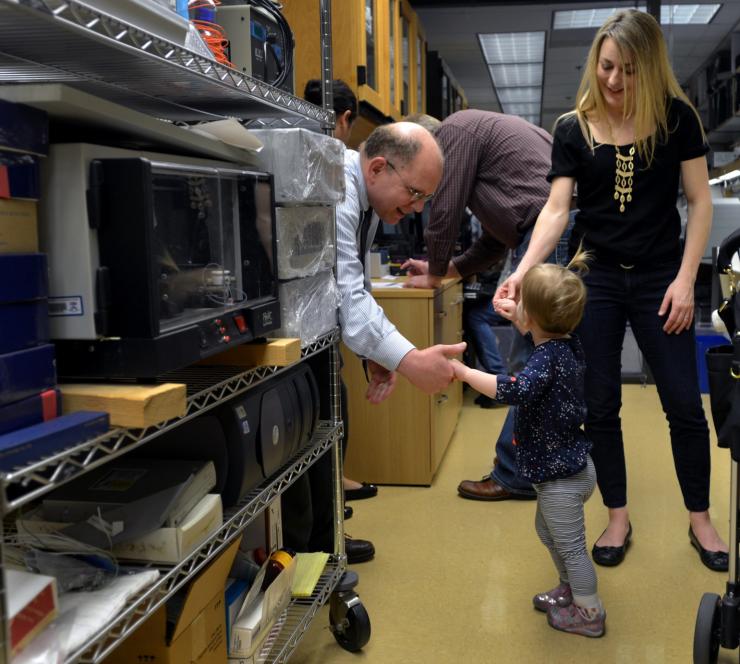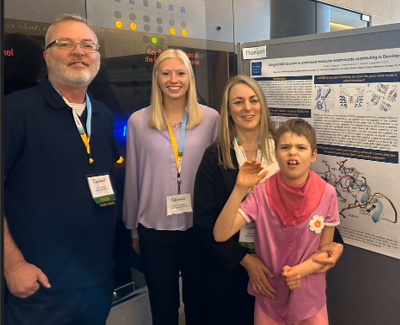Family, friendship and scientific collaboration are part of research that has shed light on a rare form of epilepsy
A decade ago, a family searching for answers to their child’s mysterious diagnosis of “KCNQ2” found the lab of Dr. Edward C. Cooper, associate professor of neurology, neuroscience and molecular and human genetics at Baylor College of Medicine. Today, that family is part of a new study that has identified disease-causing mechanisms responsible for the rare form of epilepsy their daughter lives with.
The research, published today as a Reviewed Preprint in eLife, helps to advance understanding of why and how variants in KCNQ2 cause this neurodevelopmental disorder.
“KCNQ2 encephalopathy includes a spectrum of neurodevelopmental impairments caused by different variants in the KCNQ2 gene. KCNQ2 provides the recipe for a type of brain potassium channel,” said lead author Timothy Abreo, a student in the Genetics and Genomics Graduate Program at Baylor. “The disorder usually manifests as seizures beginning within days after birth and developmental delays, which are lifelong and without current effective treatment.”

Scotty Sims and Jim Johnson’s daughter suffered from nearly continuous epileptic seizures in her first month of life. Diagnosed with a KCNQ2 genetic change of uncertain significance, her parents began a search for researchers studying the gene. When their daughter was just 6 months old, they found Cooper’s lab and shared her history and test results. This led Cooper and others to study the child’s illness and seek better treatments. Now 12, their daughter uses an adaptive communication device to make requests and uses modified sign language. Read about their first visit to the Cooper Lab here.
Variants in the KCNQ2 gene are now known to be among the more common genetic causes of epilepsy in early infants, yet the reasons why some variants lead to mild illnesses and others more disabling have remained poorly understood.
In the current study, Abreo and his colleagues gained focus when genetic testing revealed a single amino acid change – glycine 256 changed to tryptophan (G256W) – on one copy of the KCNQ2 gene. This change was previously unknown and remained unique for several years. The team carefully characterized the clinical and developmental history of the young patient. In infancy, developmental delays became apparent, and she subsequently was diagnosed with cortical visual impairment and autism spectrum disorder.
The researchers followed the scientific literature and later found three other individuals in Asia and the EU with the same G256W variant and symptoms similar to the U.S. patient. This observational study component allowed the team to specify the features to be modelled in the laboratory.
They analyzed the pathogenicity of the G256W variant using molecular, cellular and in vivo approaches. They modelled the structural consequences based on reported cryo-electron microscopy structures of the KCNQ2 channel and other closely related channel proteins.
Like other potassium channels, KCNQ2 possesses three critical regions called the turret, the pore helix and the selectivity filter. Disease causing variants tend to lie in residues near the selectivity filter, due to its crucial role enabling ions to flow. However, the G256 amino acid lies relatively far from the selectivity filter, which would typically indicate that a variant could be less likely to cause illness. The team uncovered evidence that G256 helps form a network of hydrogen bonds that serve to stabilize the structure of the pore-forming region. This provided a novel hypothesis for why an amino acid mutation so distant from the selectivity filter might be pathogenic.
Next, Abreo and colleagues conducted a series of experiments in which they introduced the G256W variant into cells alongside normal KCNQ2 and KCNQ3 genes. They measured electrical activity in the cells and observed that the presence of the G256W variant suppressed the function of the normal gene and reduced the ion current generated by the cells.
Finally, they used Crispr/Cas9 gene editing techniques and generated mice carrying the same G256W variant. Mice with G256W showed alterations in the distribution of KCNQ2 and KCNQ3 proteins within the brain, specifically in a region called the hippocampus that plays essential roles in learning and memory.
They found that, in the mouse models, KCNQ2 and KCNQ3 proteins were shifted from their usual location in axon initial segments to the neuronal somata, which is expected to diminish their ability to contribute to neuronal firing. Other experiments showed that the levels of KCNQ2 protein were decreased by roughly 50%, and the neurons in the CA1 region of the hippocampus showed heightened excitability, potentially indicating greater seizure susceptibility. Indeed, newborn and older G256W mice had spontaneous seizures that led to premature mortality not seen in control mice.
“Taken together, our study reveals that the presence of KCNQ2 G256W variants affects both molecular and cellular aspects of KCNQ channel activity, including their ion-conducting ability, expression and placement within cells,” said Cooper, who is the study’s senior author. “These changes likely play roles in the pathogenicity of the variant, and in the clinical symptoms of KCNQ2 encephalopathy observed in the individuals with this variant.”
“Our results may be broadly applicable because the majority of KCNQ2 encephalopathy patients share variants near the selectivity filter,” added Abreo.
In addition to caring for their child, Sims and Johnson have for a decade pursued efforts to connect and support a community of families with children living with KCNQ2 illnesses worldwide. Scotty founded the KCNQ2 parents’ group on Facebook, which has grown to about 900 members, and the couple jointly founded the KCNQ2 Cure Alliance, a nonprofit organization that offers support and information to families and caregivers, information on clinical trials, and raises funds for research. Jim Johnson introduced Cooper to co-author Dr. Cathleen Lutz and colleagues at the Rare Disease Translational Center, the Jackson Laboratories (Bar Harbor, Maine), leading to the development of KCNQ2 mice including those studied by Abreo and others.

“As parents and leaders of a parent-led foundation representing the global impacts of KCNQ2, we have come to fully recognize the necessity of alliance between advocacy and research,” said Johnson. “This is a foundational study of animal models and molecular mechanisms. Our hope is that the outcome of studies like this one started with Baylor, Jackson Labs and others will serve as a catalyst. Our shared goal is unlocking the mysteries of epilepsy and in service of better patient outcomes and precision medicine therapies.”
When Johnson and Sims first reached out to Cooper's lab the goal was to learn more about this disorder and has grown into new discoveries.
"Ten years ago Scotty and I were just stubborn parents calling prestigious biomedical research institutions with a plea for help and to understand the struggle of our child and others," Johnson said. "It's rewarding and heart warming to see the outcome of those that heard our message and cared to act."
And researchers say their work is not done. They highlight that, although mice with the G256W variant show spontaneous convulsive seizures and seizure-related deaths, they do not exhibit the very early onset and high frequency seen in people with the same variant.
“This difference merits more investigation,” they wrote. In addition, “selective KCNQ2 openers, which counter the effects of G256W in vitro as shown in our study, should be tested in mutant animals and, if effective, in humans with KCNQ2 disease-causing variants,” Cooper said.
In addition to Abreo, Cooper and others at Baylor and Lutz at Jackson Labs, collaborators in the published paper include Alfred George and others at Northwestern University, Anastasios Tzingounis and others at the University of Connecticut, Kristen Park and others at Children’s Colorado, and Lisa Dudler and colleagues at the Center for Human Genetics, Tubingen, Germany.
Funding for the work includes grants from the Jack Pribaz Foundation, Citizens United for Epilepsy Research, the Miles Family Fund, CPRIT, NCI and NINDS.











